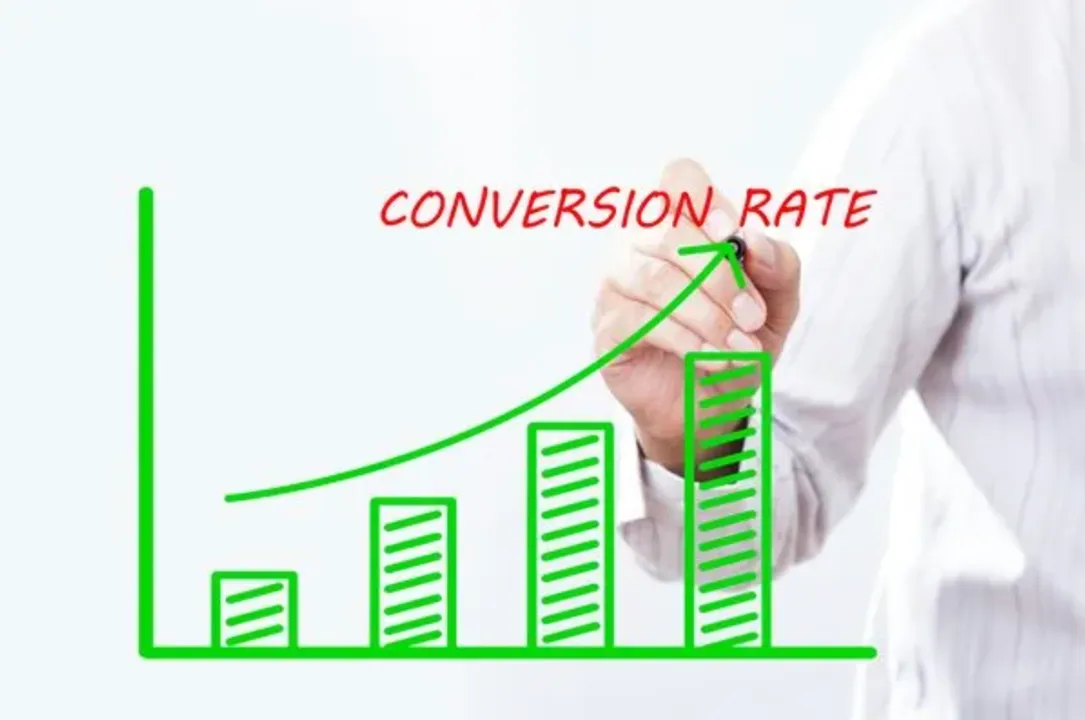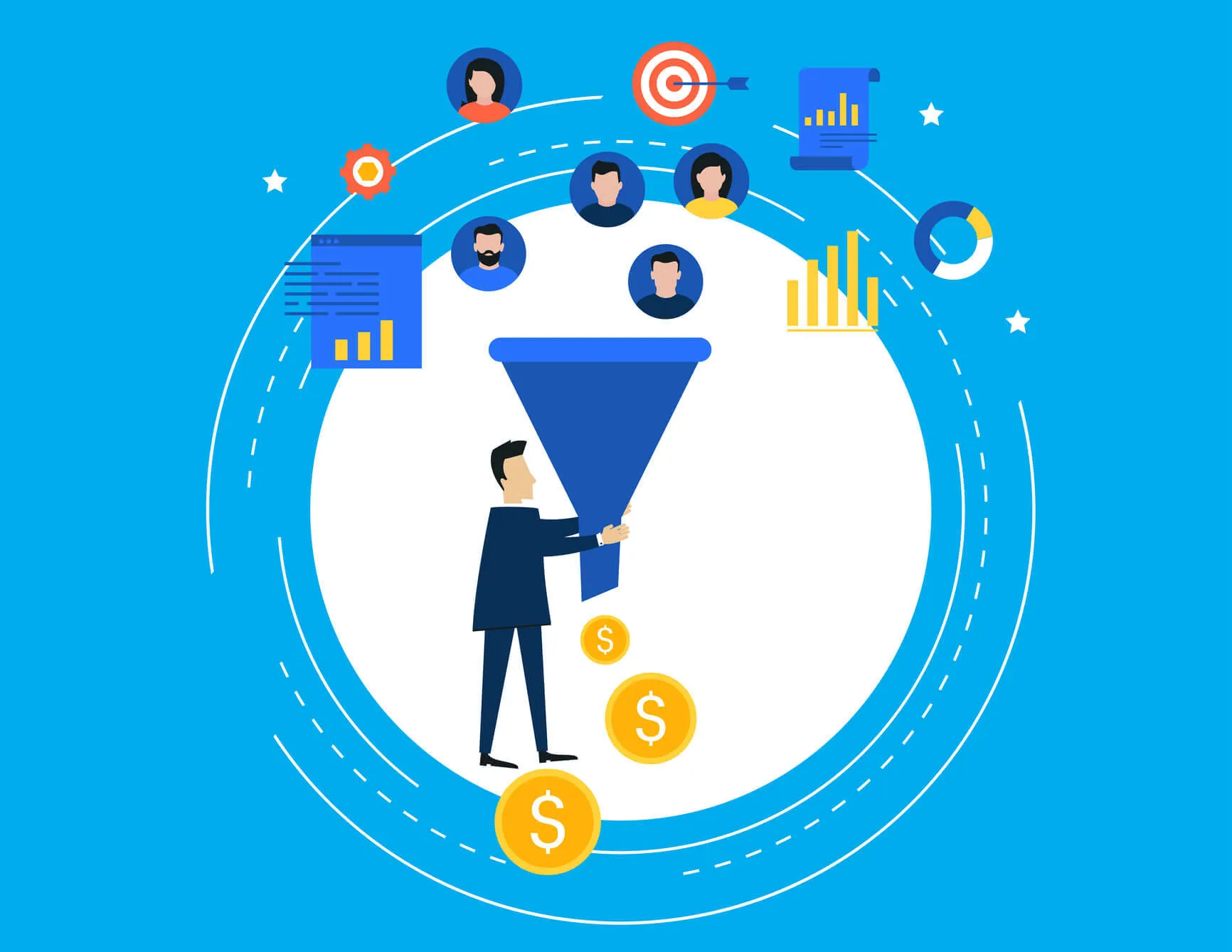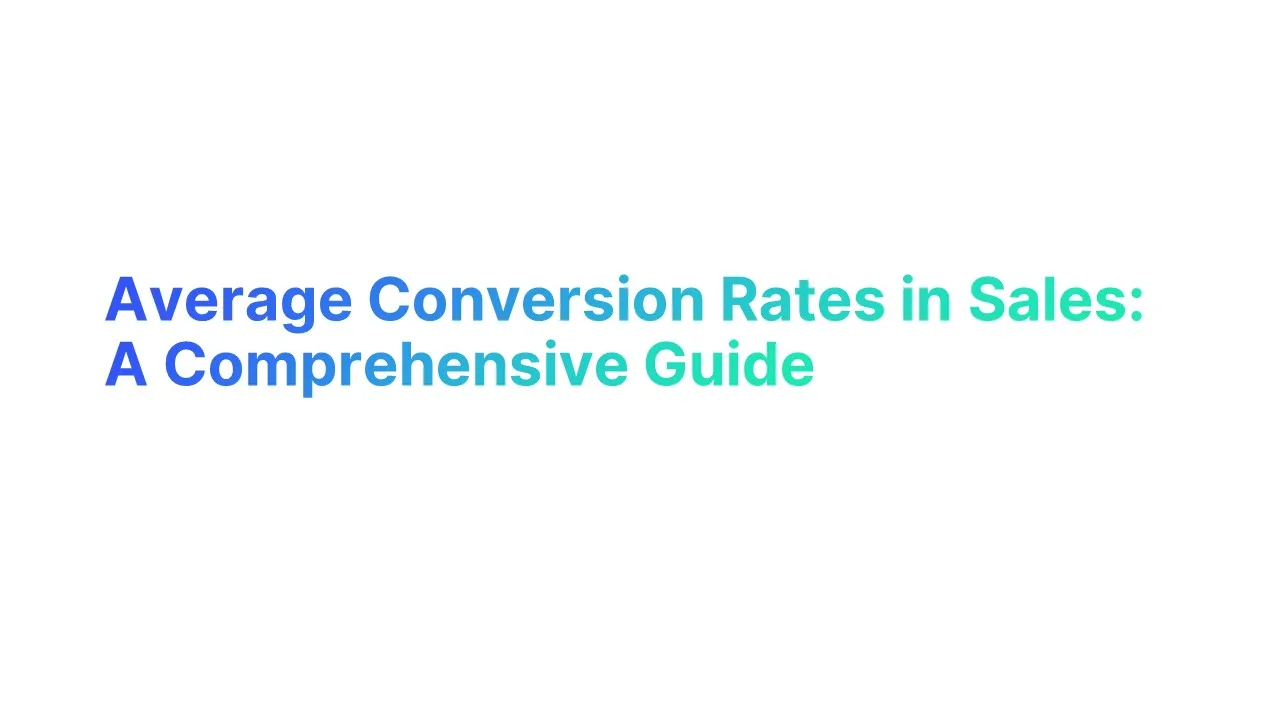What is the Lead Conversion Rate

Lead conversion rates are pivotal in assessing the effectiveness of sales and marketing efforts. At its core, a conversion rate measures how often an intended action—like filling out a lead capture form, making a purchase, or becoming a paying customer—is completed by potential customers.
This key metric serves as a quantifiable reflection of how well your marketing strategy and sales funnel are performing in converting leads generated through various channels, including social media marketing, Google Ads, and content marketing, into qualified leads and ultimately, customers.
Importance of Average Lead Conversion Rate

The average lead conversion rate is a vital metric that serves as a barometer for the health and efficiency of a company's sales and marketing efforts, especially for SaaS companies where the alignment of product offerings with customer needs is crucial. Understanding and optimizing this rate is key to driving sustainable revenue growth and ensuring the long-term success of the business.
Benchmark for Performance: The average lead conversion rate provides a clear benchmark for measuring the effectiveness of your sales teams and marketing strategies. It helps in objectively evaluating how well your company's products resonate with the target market and the efficiency of the buyer's journey from initial contact to sale.
Insight into Customer Behavior: Analyzing changes in the lead conversion rate can offer valuable insights into customer behavior and preferences. It enables companies to adapt their offerings and marketing messages to better meet the needs of their website visitors, improving the overall customer experience.
Cost Management: By understanding the average lead conversion rate, businesses can more accurately calculate the cost of acquiring new customers and assess the conversion ROI. This is particularly important for SaaS companies that often rely on subscription-based models, where the value of a customer is realized over time.
Guidance for Strategy Adjustment: A consistent review of lead conversion metrics allows businesses to identify areas for improvement. Whether it's refining the sales pitch, enhancing the company's products, or optimizing the website for better user engagement, understanding your lead conversion rate guides strategic decisions that can significantly improve performance.
Revenue Growth: Ultimately, improving your lead conversion rate directly contributes to increased revenue. By efficiently converting a higher percentage of leads into paying customers, companies can achieve substantial revenue growth without necessarily increasing the volume of leads generated.
What is a Good Lead Conversion Rate?
A good lead conversion rate is an essential indicator for businesses aiming to gauge the effectiveness of their marketing campaigns and sales efforts. It measures the proportion of leads that take a desired action, ultimately becoming paying customers. This rate not only reflects the quality of lead capture initiatives and marketing content but also the efficiency of the lead nurturing process and the effectiveness of sales reps in converting prospects.
Key Components of Lead Conversion
- Lead Conversion Metrics: These metrics quantify the success of converting potential leads into customers. A higher conversion rate signifies more efficient marketing and sales processes.
- Sales Qualified Leads (SQLs): These are leads that have been evaluated and deemed ready for the sales process, often resulting in higher conversion rates.
- Web Form and Lead Capture: The design and strategy behind web forms play a pivotal role in capturing high-quality leads, which are more likely to convert.
- Nurturing Process: The journey from lead capture to conversion involves a strategic nurturing process, where marketing teams engage leads with relevant content to guide them through the sales funnel.
Determining a "Good" Lead Conversion Rate
The benchmark for a "good" lead conversion rate can vary widely across different industries and business models. However, a general rule of thumb is:
- Average Rates: Across industries, an average conversion rate falls between 2% to 5%. This range serves as a baseline for businesses to compare their performance.
- Industry-Specific Benchmarks: Certain sectors may experience higher average conversion rates due to the nature of the products or services offered and the purchasing behavior of their target audience.
- Company Goals: Ultimately, a good conversion rate should align with the company's specific objectives, growth targets, and historical performance.
Calculating Lead Conversion Rate

Understanding and calculating your conversion rate is crucial for gauging the success of your sales and marketing efforts.
It offers a clear picture of how effectively your team is converting leads into paying customers, directly impacting your revenue and growth potential.
A solid grasp of your conversion rates enables you to make informed decisions, optimize strategies, and ultimately, secure more success for your business.
Step-by-Step Guide to Calculate Lead Conversion Rate
Calculating your lead conversion rate doesn't have to be complicated. By following a simple formula, you can get lead conversion metrics and gain valuable insights into the efficiency of your sales process and the effectiveness of your sales team. Here's how to do it:
Total Number of Conversions: Start by determining the total number of leads that have been successfully converted into customers within a specific period.
Total Number of Leads: Identify the total number of leads generated in the same period. These leads could come from various sources, including marketing campaigns, Google Analytics, or direct inquiries.
The Formula: Use the following formula to calculate lead conversion rate for your lead conversion rate:
Lead Conversion Rate (%)=(Total Number of Conversions/Total Number of Leads)×100
Interpretation: The resulting percentage gives you a direct insight into how effectively your sales team is working and how well your marketing efforts are resonating with your target audience.
By regularly calculating your average lead conversion rate, you can track performance over time, identify trends, and make necessary adjustments to improve your results.
Tools and Techniques for Accurate Conversion Measurements
Accurately measuring conversion rates requires more than just a good formula; it requires the right tools and techniques. Here are some essentials:
Google Analytics: A powerful tool for tracking website visitors' behavior, Google Analytics can help you understand how leads interact with your site and at which point they convert.
CRM Software: Customer Relationship Management (CRM) software can track how many leads move through the sales pipeline, from initial contact to conversion, providing detailed insights into the conversion process.
A/B Testing: Experiment with different aspects of your sales and marketing strategy, such as landing page designs or email marketing content, to see what yields higher conversion rates.
Conversion ROI: Calculate the return on investment (ROI) for your conversions to understand the value each lead brings in comparison to the cost of acquiring them. This is crucial for budgeting and for evaluating the effectiveness of different marketing strategies.
Segmentation: Break down your data by various segments, such as source, campaign, or demographic information, to identify which areas are performing well and which need improvement.
Using these tools and techniques, you can gather accurate data, analyze your performance, and make informed decisions to improve your lead conversion rates.
The goal is not just to generate more leads, but to convert more of them into paying customers, ultimately leading to marketing qualified leads, more money and success for your business.
Industry Insights: Lead Conversion Rate Benchmarks
In the dynamic landscape of digital marketing, understanding industry-specific conversion rate benchmarks is crucial for businesses aiming to gauge their performance against competitors.
For SaaS companies and other sectors, these benchmarks provide a clear perspective on what constitutes a good lead conversion rate, helping to set realistic goals and strategies for improvement.
Unveiling Average Conversion Rates by Industry
Each industry has its unique customer behavior patterns, sales cycles, and product or service complexities, which influence average conversion rates. Here's a snapshot of average conversion rates by industry:
E-Commerce: Typically sees an average conversion rate of around 2-3%. The relatively low conversion rate here is due to the high volume of traffic and the wide range of choices available to consumers.
SaaS: SaaS companies often have higher conversion rates, ranging from 5-10%, thanks to targeted lead generation strategies and the nature of the product offering.
Real Estate: With its high-value transactions, the real estate industry usually experiences conversion rates between 2-3%, similar to e-commerce but with a significantly different sales process and lead value.
Healthcare: This industry's conversion rates can vary widely but generally hover around 4-5%, influenced by the personal nature of the service and the level of online research conducted by potential patients.
Comparing your company's lead conversion rate with these industry averages can provide valuable context, helping you to set realistic goals and identify areas where your lead capture and lead conversion and strategies might need tweaking.
Channel-Specific Lead Conversion Rates: A Detailed Examination
Beyond industry averages, it's essential to delve into the conversion rates associated with specific marketing channels. This detailed examination can unearth actionable insights, enabling you to allocate your resources more effectively:
Email Marketing: Often boasts high conversion rates due to its personalized nature, with averages ranging from 6-10% depending on the industry and the quality of the mailing list.
Paid Search: Conversion rates for paid search campaigns can vary widely but typically fall between 2-5%. The key to improving these rates lies in targeting the right keywords and crafting compelling ad copy.
Social Media: While social media can be great for engagement, its conversion rates are generally lower, around 1-2%. However, with the right strategy, it's possible to significantly improve these numbers.
Organic Search: Traffic from organic search can convert at a rate of 2-4%, influenced by the relevance and ranking of your content.
Understanding these channel-specific nuances can lead to more informed decisions about where to invest your marketing budget.
For instance, if your SaaS company's email marketing campaigns are underperforming compared to the channel average, it might be time to revamp your approach or invest more in channels where your conversion rate is already strong.
By continuously monitoring both industry and channel-specific conversion rates and adjusting your strategies accordingly, you can ensure that your various lead generation campaigns and conversion efforts are as effective as possible, ultimately leading to increased total sales and a better return on investment.
Strategies for Improving Your Lead Conversion Rate
The journey from lead generation to converting those leads into paying customers is critical. It's not merely about the total lead volume; it's about enhancing the lead value and ensuring a higher rate of leads converted into customers. This journey impacts the overall success of marketing campaigns and the total sales value, making it imperative to refine the lead generation process and nurturing strategies. Here are key strategies to improve your lead conversion rate, ensuring every step from capturing leads via a lead capture form to their transition into paying customers is optimized for maximum efficiency.

1. Optimize Web Forms for Simplicity and Efficiency
The lead capture form is often the first point of interaction between your potential customer and your business. Making this process as frictionless as possible can significantly increase the number of leads entering your marketing funnel.
- Simplify forms to only the most essential fields to reduce abandonment.
- A/B test different form designs and layouts to find the most effective version
2. Personalize Communication to Align with Lead Interests
Once leads are captured, personalizing your communication can make a significant impact. Tailoring messages to address the specific needs and interests of your leads can increase engagement and move them closer to conversion.
- Use historical data to segment your leads based on behavior and preferences.
- Craft messages that resonate with the specific segments, enhancing relevance.
3. Implement Lead Scoring to Prioritize Potential Conversions
Not all leads hold the same potential for conversion. Implementing a lead scoring system allows your sales reps to focus their efforts on leads that are most likely to become customers.
- Develop criteria for scoring leads based on their interactions with your content, responsiveness to previous communications, and other relevant factors.
- Regularly review and adjust the scoring criteria to align with evolving marketing goals.
4. Develop Targeted Lead Nurturing Campaigns
The nurturing process begins the moment a lead enters your funnel. Creating targeted campaigns that guide leads through the buyer's journey is essential for moving them from awareness to decision-making.
- Create a series of emails that provide value at each stage of the marketing funnel, gradually building trust and authority.
- Include relevant content that addresses common questions or concerns, aiding the decision-making process.
5. Create Specific Landing Pages for Different Campaigns
Custom landing pages tailored to specific marketing campaigns can greatly enhance lead conversion. Each page should be designed to match the messaging of the campaign that directed the lead there, providing a cohesive experience.
- Design landing pages that focus on a single call to action, reducing distractions and guiding leads toward conversion.
- Use testimonials, case studies, and other forms of social proof to build credibility and trust.
6. Craft Clear and Compelling Calls-to-Action (CTAs)
Creating effective Calls-to-Action (CTAs) is pivotal in guiding leads through the conversion process. A well-designed CTA not only captures attention but also encourages potential customers to take the next step, whether it's signing up for a service, making a purchase, or downloading a resource.
- Use straightforward, action-oriented language that tells leads exactly what you want them to do.
- Phrases like "Limited Time Offer" or "Download Now" can motivate leads to act immediately.
- Design CTAs that stand out with vibrant colors or unique shapes to draw the eye and prompt action.
7. Utilize Retargeting Strategies to Re-Engage Dropped Leads
Retargeting is an invaluable tactic for re-engaging leads who showed initial interest but did not complete a conversion action. By targeting these leads with specific content or offers, you can encourage them to revisit your landing page and complete the desired action.
- Categorize dropped leads based on their interaction level and tailor retargeting efforts accordingly.
- Use data from their previous interactions to create retargeting ads that speak directly to their interests or pain points.
- Monitor the frequency of retargeting ads to avoid overwhelming or annoying potential leads.
8. Offer Live Chat or Chatbots for Real-Time Engagement
Incorporating live chat or chatbots on your landing pages can significantly enhance the user experience by providing instant assistance. This real-time interaction can address any questions or concerns leads might have, helping to move them closer to conversion.
- Chatbots can offer constant support, ensuring leads have access to assistance no matter the time of day.
- Tailor chat responses based on the specific landing page or campaign, making the interaction more relevant to the lead's interests.
- Use chat interactions to further qualify leads, saving valuable time for your sales team by focusing on the most promising prospects.
9. Provide Social Proof through Testimonials and Case Studies
Social proof, such as testimonials and case studies, can significantly influence a lead's decision to convert. Showcasing real-world examples of your product or service's success builds trust and credibility with potential customers.
- Include genuine testimonials from satisfied customers that highlight the benefits of your offering.
- Share in-depth case studies that demonstrate how your product or service solved a particular problem or achieved specific results.
- Utilize social proof from a variety of sources, including social media, to enhance credibility.
10. Continuously Analyze and Refine Your Strategy Based on Data.
The key to improving lead conversion rates lies in ongoing analysis and refinement of your marketing strategies. Utilize data to objectively measure the effectiveness of your campaigns and make informed decisions for future optimizations.
- Regularly review key performance indicators, such as conversion rates and cost per acquisition, to gauge the success of your campaigns.
- Continuously test different elements of your landing pages and campaigns, from CTAs to content and design, to identify the most effective strategies.
- Stay adaptable and be willing to adjust your strategies based on performance data and changing market trends, ensuring your campaigns remain relevant and effective.
Conclusion
Understanding and optimizing the average conversion rate is crucial for any business looking to thrive in today's competitive landscape. It serves as a vital benchmark that reflects the effectiveness of your marketing campaigns, sales strategies, and overall customer engagement.
By continuously monitoring this metric, companies can identify areas for improvement, tailor their approaches to meet the specific needs of their target audience, and ultimately drive more successful conversions. Whether you're a fledgling startup or an established enterprise, focusing on enhancing your average conversion rate can lead to significant gains in customer acquisition, retention, and revenue growth.
The key to success lies not just in attracting leads but in effectively converting them into loyal customers.
Further Reading
To further enhance your understanding of conversion rates and refine your sales and marketing techniques, consider exploring the following resources on our blog. These articles offer additional insights and practical advice to improve the effectiveness of your sales funnel:
- Unlock the Secrets of an Optimized Lead Funnel for Higher Conversion Rates: Discover key strategies to optimize your lead funnel, ensuring maximum conversion efficiency from initial contact to close.
- Understanding Open Rate for Email: What You Need to Know: Learn about email open rates, an essential metric for evaluating the success of email marketing campaigns and its impact on overall conversion rates.
- 9 Ways to Optimize Your Website for Lead Generation: Explore practical steps to enhance your website's design and functionality, boosting its capability to capture and convert leads.
- The Essentials of Inbound Marketing: Gain insights into inbound marketing techniques that attract customers through content creation, social media, SEO, and more, contributing to higher conversion rates.
- Cold Email Conversion Rate: Tips and Strategies: Delve into tactics for improving your cold email strategies, directly influencing your ability to convert prospective customers into active buyers.
These resources are crafted to deepen your knowledge on average conversion rates and provide actionable strategies that can significantly improve your sales outcomes, ensuring you make the most effective use of every sales opportunity.








